Mortgage and landlord possession statistics: July to September 2022
Published 10 November 2022
1. Main Points
This publication provides mortgage and landlord possession statistics up to July to September 2022. In general, we have compared figures to the same quarter in the previous year. Should users wish to compare the latest outturn against 2019 as a pre-covid baseline, or to a time period during the covid period, they can do so using the accompanying statistical tables. For technical detail, please refer to the accompanying supporting document.
| Mortgage claims, orders, warrants and repossessions have increased significantly when compared to the same quarter in 2021. | Compared to the same quarter in 2021, mortgage possession claims increased from 2,832 to 3,680 (30%), orders from 1,229 to 2,491 (103%), warrants from 947 to 2,437 (157%) and repossessions by county court bailiffs increased from 390 to 744 (91%). These figures are between 50% to 60% of pre-covid baselines. |
| Landlord possession actions have all increased significantly. | The pattern is repeated for landlord possession actions. When compared to the same quarter in 2021, landlord possession claims increased from 10,202 to 21,012 (106%), orders from 5,601 to 15,352 (174%), warrants from 4,552 to 8,505 (87%) and repossessions from 4,891 to 5,403 (10%). |
| Mortgage and Landlord possession claims rates have risen across all regions. | Increases in possession claims have been recorded in all regions. Landlord claims remained concentrated in London (with 9 of the highest 10 claim rates). |
| Mortgage median average time (from claim to repossession) has decreased. | The median average time from claim to mortgage repossession has decreased to 60.1 weeks, down from 114.7 weeks in the same period in 2021. |
| Median timeliness for landlord repossessions has decreased when compared to 2021. | The median average time from claim to landlord repossession has decreased to 22.3 weeks, down from 68.6 weeks in the same period in 2021. |
A data visualisation tool has also been published that provides further breakdowns in a web-based application. The tool can be found here.
For feedback related to the content of this publication and visualisation tool, please contact us at CAJS@justice.gov.uk
2. Statistician’s Comment
This report covers the quarter to the end of September 2022 and shows continued recovery in all court actions when compared to the same period last year. These figures follow very similar trends to the previous quarter. Some headline examples of this are summarised below.
Firstly, claim volumes for Mortgage and Landlord Possession, which have increased quarter on quarter since Q2 2021 with claim receipts now hovering around 70% of the pre-covid baseline. Within that, Social Landlord claims remain significantly below pre-Covid levels but have increased to their highest level since March 2020.
Secondly, Private Landlord and Accelerated Procedure volumes have surpassed pre-pandemic Covid levels with Private landlord claims recording the highest level ever, this quarter.
Thirdly, Orders and Warrants of Possession issued have followed similar trends to receipts. They are still below pre-covid levels but numbers have been rising steadily since restrictions ended.
Finally, timeliness figures have decreased across all mortgage and landlord stages. Median and mean average time has decreased for orders, warrants and repossessions compared to the same period last year.
Where numbers presented are significantly below pre-covid levels, any volatility should be considered within the context of the relatively small volumes and the invariable additional time needed where normal court procedures could not be followed.
3. Overview of Mortgage Possession
Mortgage possession actions: claims, orders and warrants are currently around 30%, 103% and 157% above the previous year’s levels.
Compared to the same quarter in 2021, mortgage possession claims (3,680) are up 30%. Mortgage orders for possession (2,491) are up 103%, warrants issued (2,437) are up 157% and repossessions (744) are up 91%.
Figure 1: Mortgage possession actions in the county courts of England and Wales, July to September 2017 to July to September 2022 (Source: Table 1)
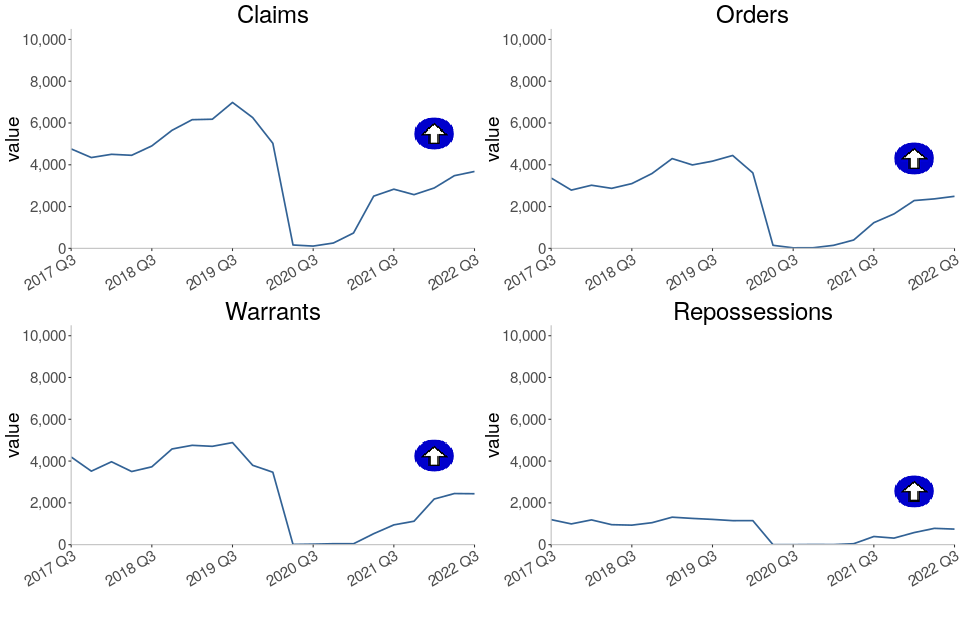
All Mortgage possession case types have been steadily increasing since Q3 2021. Claims, warrants and repossessions volumes are now at 53%, 50% and 62% of their pre-covid baseline. This is a significant increase when compared to the same quarters in 2020 and 2021 however it is still short of the pre-covid 2019 baseline.
Mortgage possession claims fell from a peak of 26,419 in April to June 2009 before stabilising from April to June 2015 (4,849, see table 1). In the most recent quarter, July to September 2022, there were 3,680 claims for possession, up 30% from the same quarter in 2021.
Orders and warrants for possession followed a similar trend to mortgage claims, falling from a peak of 23,850 orders in July to September 2009 and 21,350 warrants in January to March 2009, and stabilizing around 2016/17. Compared to the same quarter in 2021, orders are up 103% to 2,491 and warrants are up 157% to 2,437 in July to September 2022.
Historically, repossessions by county court bailiffs fell from a high of 9,284 in Q1 of 2009 to 934 in Q3 of 2018, the lowest recorded level of the series at the time. Following the complete cessation of repossession proceedings from March to September 2020 where no repossessions took place, the FCA guidance advised mortgage lenders not to commence or continue possession proceedings until April 2021 (unless there were special circumstances). As a result, there were only 10 repossessions from April 2020 to March 2021 (Q2 2020 to Q1 2021), and 744 in July to September 2022, up 91% compared to the same quarter in 2021.
Before the impact of coronavirus, the historical fall in the number of mortgage possession actions since 2008 has generally coincided with lower interest rates, a proactive approach from lenders in managing consumers in financial difficulties and other interventions, such as the Mortgage Rescue Scheme and the introduction of the Mortgage Pre-Action Protocol. Additionally, the downward trend seen in recent years mirrors that seen in the proportion of owner-occupiers.
4. Mortgage Possession Action Timeliness
Median timeliness figures have decreased for all actions; claim to orders, claim to warrant and claim to repossession.
Median average time has decreased for orders and warrants. As the courts continue to recover, it is unlikely that these timeliness figures are representative of any statistical trend and instead reflect the pause in actions, therefore, caution should be used when interpreting these results.
The median average time from claim to repossession has decreased to 60.1 weeks, down from 114.7 weeks in the same period in 2021. However, it should be noted there were much fewer cases during July to September 2021.
Figure 2: Average timeliness of mortgage possession actions, July to September 2017 to July to September 2022 (Source: Table 3)
Number of weeks taken from initial mortgage claim to…

-
Claims to order median timeliness has decreased to 8.6 weeks, down from 15.1 weeks in the same period in 2021.
-
Claims to warrant median timeliness has decreased to 52.9 weeks, down from 91.0 weeks in the same period in 2021.
-
Claims to repossession median timeliness has decreased to 60.1 weeks, down from 114.7 weeks in the same period in 2021.
The above charts distinguish between the timeliness of possession claims at different stages of a case. Average time taken from claim to warrant or repossession can fluctuate and is affected by various factors. For example, the final two charts take account of the amount of time between the court order being issued and the claimant, such as the mortgage lender, applying for a warrant of possession.
The long-term increases in the mean average time from claim to warrant and claim to repossession are due to an increasing proportion of historic claims reaching the warrant and repossession stages respectively in recent quarters. This is possibly due to defendants recently breaking the terms of the mortgage agreements put in place at the start of the process. Although these historical outlying cases inflate the mean average, they have less effect on the median.
5. Overview of Landlord Possession
The number of landlord possession actions for all court stages have increased compared to the same quarter of last year.
Compared to the same quarter in 2021, landlord possession actions; claims (21,012), orders for possession (15,352), warrants (8,505) and repossessions (5,403) have increased by 106%, 174%, 87% and 10% respectively.
Figure 3: Landlord possession actions in the county courts of England and Wales, July to September 2017 to July to September 2022 (Source: Table 4)
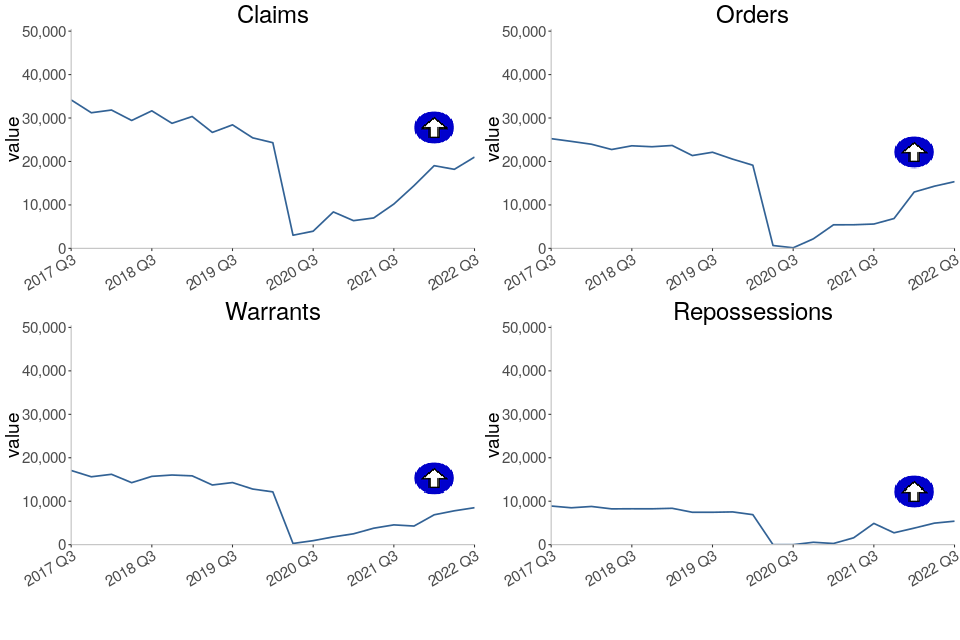
In July to September 2022, a similar proportion (36% or 7,570) of all landlord possession claims were social landlord claims compared to private landlord claims (32% or 6,823). 32% (6,619) were accelerated claims.
This contrasts with pre-covid proportions. For example, in July to September 2019, the majority (62% or 17,629) of all landlord possession claims were social landlord claims, while accelerated claims and private landlord claims made up just 17% and 21% of all landlord claims respectively.
The rise in claim and orders volumes is observed across all geographical regions. As in previous quarters, a concentration was seen in London, with 5,919 landlord claims and 3,640 landlord orders at London courts in July to September 2022, accounting for 28% and 24% of the respective totals. In London, there was an increase of 118% (from 2,709 in July to September 2021) for landlord claims and an increase of 137% for landlord orders (from 1,536 in July to September 2021).
The 87% increase in landlord warrants compared to July to September 2021, was accompanied by large increases across all regions. The largest regional number (2,164) was again found in London, making up 25% of all landlord warrants. There was an increase of 50% for landlord warrants in London (from 1,442 in July to September 2021 to 2,164 in July to September 2022).
6. Landlord Possession Timeliness[footnote 1]
Median timeliness figures remain volatile for landlord orders, warrants and repossessions while volumes continue to return to pre-Covid levels.
Median and mean average time has decreased for orders, warrants and repossessions.
The median average time from claim to repossession has decreased to 22.3 weeks, down from 68.6 weeks in the same period of 2021.
Figure 4: Mean and median average timeliness of landlord possession actions, July to September 2017 to July to September 2022 (Source: Table 6)
Number of weeks taken from initial landlord claim to…

-
Claims to order median timeliness has decreased to 8.0 weeks, down from 17.6 weeks in the same period in 2021.
-
Claims to warrant median timeliness has decreased to 15.0 weeks, down from 34.4 weeks in the same period in 2021.
-
Claims to repossessions median timeliness has decreased to 22.3 weeks, down from 68.6 weeks in the same period in 2021.
As shown by Figure 4, median figures are generally considerably lower than mean figures, demonstrating that on average, the progression from claim to successive stages can be positively skewed by outlying cases when using a mean measure of average timeliness.
7. Regional Possession Claims
Medway in the South East region had the highest rate of mortgage possession claims at 34 per 100,000 households, followed by Greenwich (London region) and Slough (South East region); with 33 and 32 claims per 100,000 respectively.
The majority of the highest landlord possession claim rates were found in London, with 9 of the 10 highest rates occurring in this region. Brent had the highest rate (325 per 100,000 households).
Figure 5: Mortgage possession Claims per 100,000 households, July to September 2022 (Source: map.csv; see supporting guide)[footnote 2]
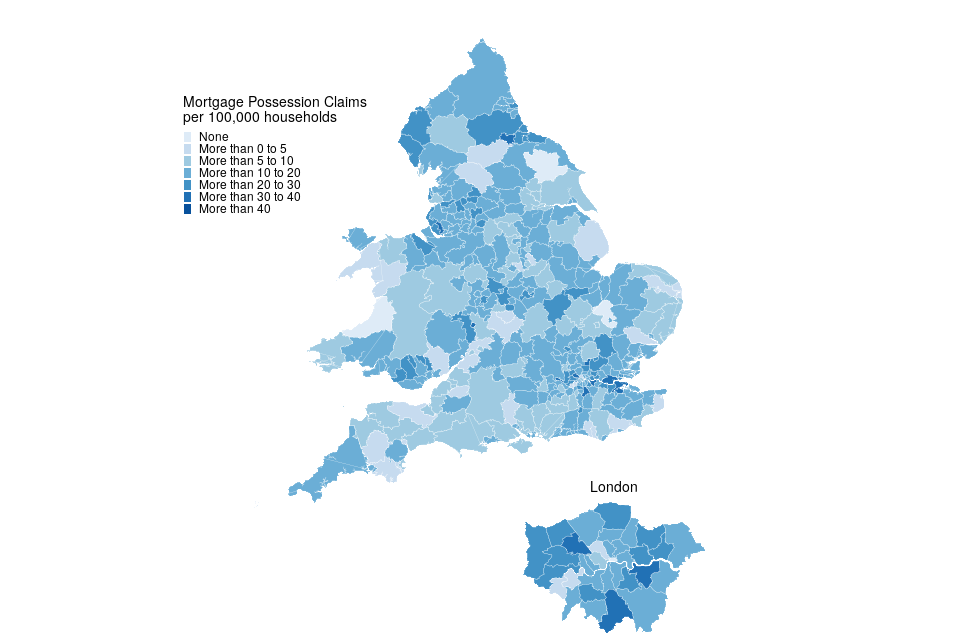
| Local Authority | Rate (per 100,000 households) | Actual number |
|---|---|---|
| Medway | 34 | 38 |
| Greenwich | 33 | 38 |
| Slough | 32 | 18 |
5 local authorities had no possession claims during this period. Excluding these, Stratford-on-Avon had the lowest rate of mortgage claims (1.7 per 100,000 households).
Figure 6: Landlord possession Claims per 100,000 households, July to September 2022 (Source: map.csv; see supporting guide)

| Local Authority | Rate (per 100,000 households) | Actual number |
|---|---|---|
| Brent | 325 | 384 |
| Newham | 295 | 344 |
| Ealing | 284 | 350 |
London boroughs accounted for 9 of the 10 local authorities with the highest rate of landlord claims.
One local authority, the Isles of Scilly, had no landlord claims during this period. Excluding this, Ryedale had the lowest rate of landlord claims (3.9 per 100,000 households).
8. Regional Repossessions (by County Court Bailiffs)
Newcastle upon Tyne had the highest overall rate of mortgage repossessions at 11 per 100,000 households.
Landlord repossessions were highest in Greenwich with 69 per 100,000 households and were generally concentrated in London (6 out of the 10 highest rates).
Figure 7: Mortgage repossessions per 100,000 households, July to September 2022 (Source: map.csv; see supporting guide)
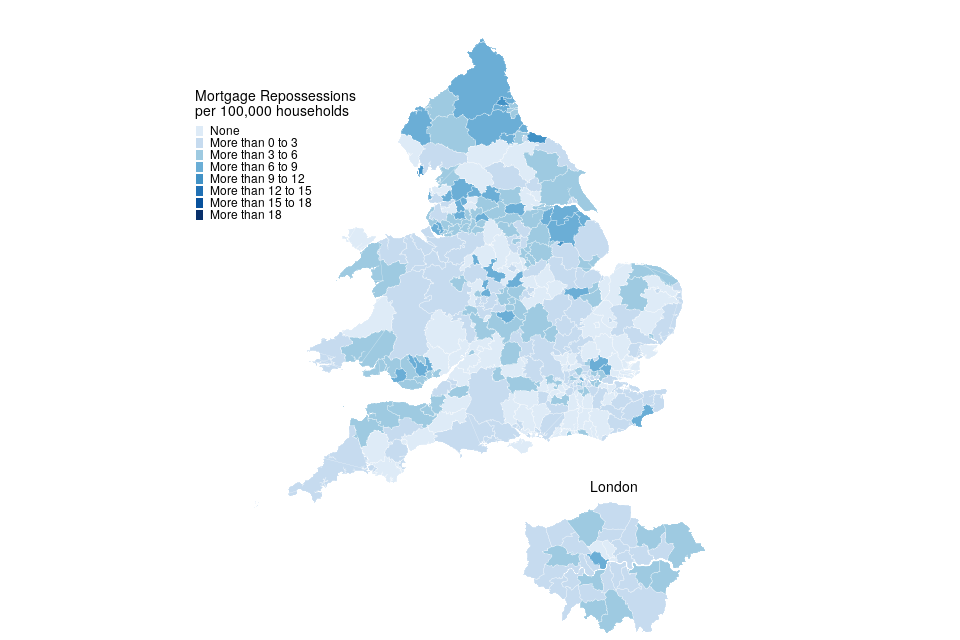
No repossessions by county court bailiffs were recorded during this period in 97 local authorities out of a total of 331.
Figure 8: Landlord repossessions per 100,000 households, July to September 2022 (Source: map.csv; see supporting guide)
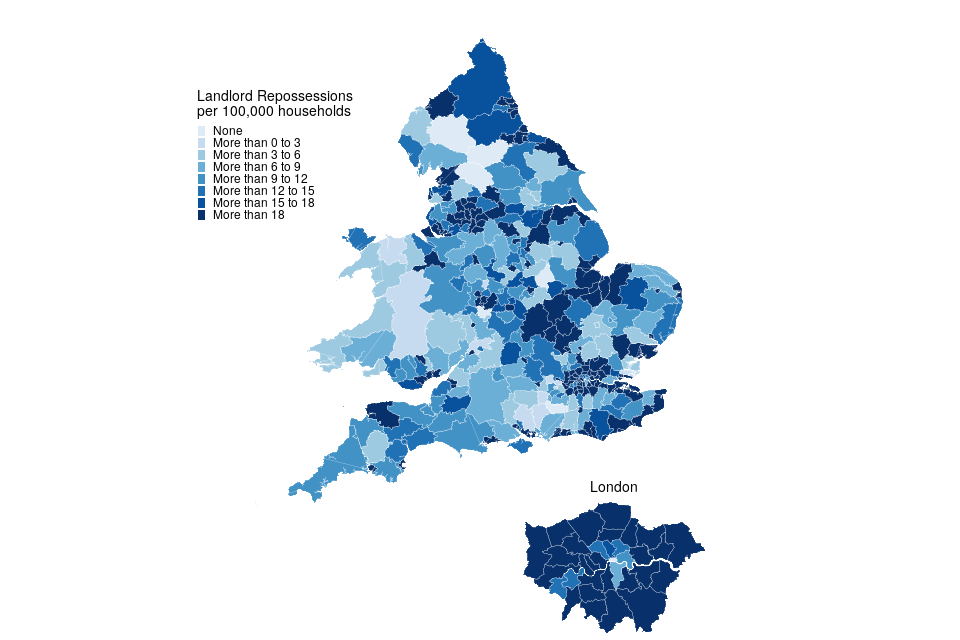
| Local Authority | Rate (per 100,000 households) | Actual number |
|---|---|---|
| Greenwich | 69 | 79 |
| Hastings | 69 | 30 |
| Lewisham | 69 | 91 |
London local authorities account for 6 of the 10 boroughs with the highest rate of landlord repossessions.
8 local authorities had no landlord repossessions by county court bailiffs in July to September 2022.
9. Further information
The statistics in the latest quarter are provisional and revisions may be made when the next edition of this bulletin is published. If revisions are needed in subsequent quarters, these will be annotated in the tables.
9.1 Accompanying files
As well as this bulletin, the following products are published as part of this release:
-
A supporting guide providing further information on how the data is collected and processed, including a guide to the csv files, as well as legislation relevant to mortgage possessions and background information.
-
A set of overview tables, covering key sections of this bulletin.
-
CSV files of the map data and the possession action volumes by local authority and county court.
-
A data visualisation tool which provides a detailed view of the Mortgage and Landlord statistics. We welcome feedback on this tool to help improve it in later editions and to ensure it meets user needs.
9.2 National Statistics status
National Statistics status means that official statistics meet the highest standards of trustworthiness, quality and public value.
All official statistics should comply with all aspects of the Code of Practice for Statistics. They are awarded National Statistics status following an assessment by the Authority’s regulatory arm. The Authority considers whether the statistics meet the highest standards of Code compliance, including the value they add to public decisions and debate.
It is the Ministry of Justice’s responsibility to maintain compliance with the standards expected for National Statistics. If we become concerned about whether these statistics are still meeting the appropriate standards, we will discuss any concerns with the Authority promptly. National Statistics status can be removed at any point when the highest standards are not maintained, and reinstated when the standards are restored. These statistics have been audited and re-accredited as National Statistics. The most recent compliance check completed by the Office of Statistics Regulation can be found here.
9.3 Future publications
Our statisticians regularly review the content of publications. Development of new and improved statistical outputs is usually dependent on reallocating existing resources. As part of our continual review and prioritisation, we welcome user feedback on existing outputs including content, breadth, frequency and methodology. Please send any comments you have on this publication including suggestions for further developments or reductions in content.
9.4 Contact
Press enquiries should be directed to the Department for Levelling Up, Housing and Communities press office:
email: newsdesk@levellingup.gov.uk
Other enquiries and feedback on these statistics should be directed to the Data and Evidence as a Service division of the Ministry of Justice:
Carly Gray - email: CAJS@justice.gov.uk
Next update: 9 February 2023
© Crown Copyright
Produced by the Ministry of Justice
Alternative formats are available upon request from ESD@justice.gov.uk
-
The law requires at least 4 and no more than 8 weeks between claim and court hearing. Possession orders stipulate when a tenant must vacate the property - typically within 4 weeks from the date the order was made. Landlords cannot issue a warrant until after this period (if the tenant has failed to comply). ↩
-
Please note the boundaries in figure 5 have been updated this quarter to better reflect the spread of mortgage possession rates. ↩
